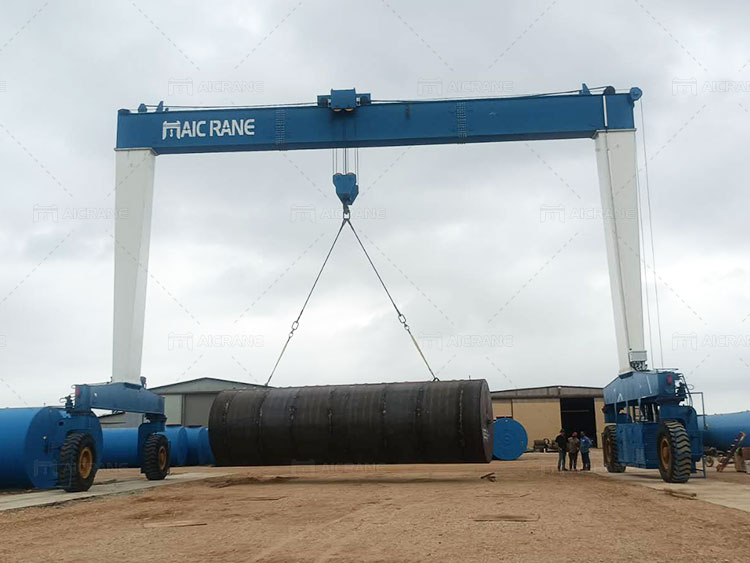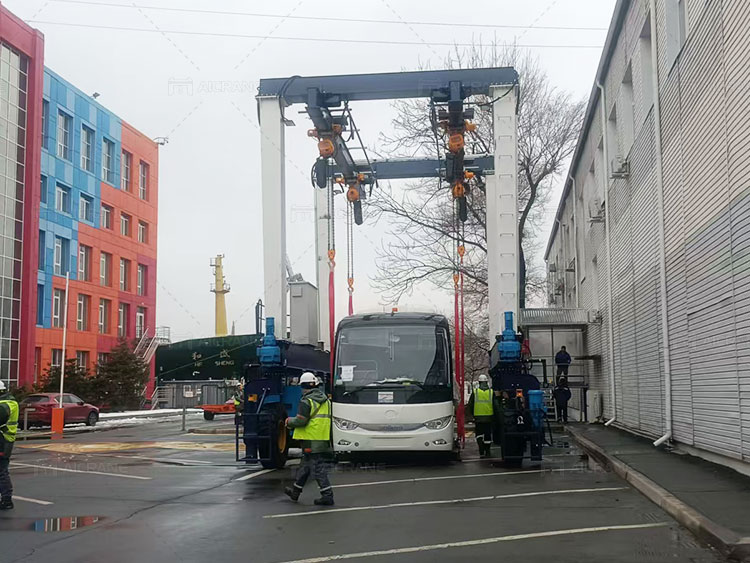Rubber Tyred Gantry (RTG) cranes have become one of the most popular lifting solutions for container handling in port terminals, construction sites, and other industrial environments. These cranes are equipped with rubber tyres instead of traditional rail tracks, offering enhanced mobility and flexibility. Their design and operation offer numerous advantages, making them a preferred choice for various material handling applications. In this article, we will explore the different types of rubber tyres used in wheeled gantry cranes and delve into their various benefits.

1. What are Rubber Tyred Gantry Cranes?
A Rubber Tyred Gantry (RTG) crane is a type of gantry crane mounted on rubber tyres, making it highly mobile. Unlike traditional rail-mounted cranes that rely on fixed tracks, rubber tyred gantry cranes are designed to move freely across the ground, giving them the ability to transport containers or heavy materials within a defined area. These cranes are most commonly used for container stacking in port terminals, for moving heavy construction materials, and in warehouses for storage and retrieval operations.
The ability to move without the need for permanent tracks or foundations makes RTGs an ideal solution for facilities that require high flexibility and mobility. This freedom of movement allows these cranes to operate in diverse environments, including indoor and outdoor settings.
2. Types of Rubber Tyres in Wheeled Gantry Cranes
The rubber tyres used in wheeled gantry cranes are a critical component that affects the crane’s mobility, stability, and overall performance. There are different types of tyres employed in these cranes, each offering specific benefits depending on the crane’s application and operational requirements.
2.1 Solid Rubber Tyres
Solid rubber tyres are the most common type of tyres used in RTG cranes. As the name suggests, these tyres are made from solid rubber without an air-filled cavity. Solid rubber tyres are durable, long-lasting, and offer a high level of stability. They are capable of withstanding heavy loads and are resistant to punctures and wear, which is especially important in harsh operating environments.
Advantages:
-
Durability: Solid rubber tyres are highly resistant to wear and tear, offering a long lifespan even in demanding conditions.
-
Low Maintenance: Since they do not contain air, they are less prone to punctures and require less maintenance compared to pneumatic tyres.
-
High Load Capacity: Solid tyres provide excellent load-bearing capabilities, making them ideal for heavy-duty applications.
-
Stability: They offer a high level of stability and balance, which is crucial when lifting and moving heavy loads.
Disadvantages:
-
Ride Quality: Solid rubber tyres tend to provide a rougher ride compared to pneumatic tyres, which may affect the smoothness of wheeled gantry crane operations.
-
Heat Generation: Due to the solid construction, these tyres can generate more heat under heavy load conditions, which could impact their longevity.

2.2 Pneumatic Rubber Tyres
Pneumatic rubber tyres are air-filled tyres similar to those used in trucks and other vehicles. These tyres offer a more flexible and cushioned ride, which can be beneficial for reducing vibrations and improving the smoothness of crane movements.
Advantages:
-
Smooth Ride: Pneumatic tyres provide a cushioned and smoother ride, which is advantageous in environments where load stability and crane movement are critical.
-
Shock Absorption: These tyres offer better shock absorption, reducing the impact on the crane structure and improving the overall operational experience.
-
Traction: Pneumatic tyres can offer better traction, particularly on uneven surfaces or in wet conditions.
Disadvantages:
-
Puncture Risk: The air-filled nature of these tyres makes them susceptible to punctures and deflation, requiring more frequent maintenance and repairs.
-
Lower Load Capacity: Pneumatic tyres typically have a lower load-bearing capacity compared to solid rubber tyres, which may limit their use in extremely heavy-duty applications.
2.3 Polyurethane-Coated Rubber Tyres
Polyurethane-coated rubber tyres are a specialized type of tyre used in some RTG mobile gantry cranes. These tyres combine the durability of rubber with the wear resistance and smoothness of polyurethane coatings.
Advantages:
-
Enhanced Durability: Polyurethane-coated tyres are highly resistant to wear, cuts, and abrasion, making them ideal for environments where tyres are subject to rough surfaces.
-
Low Rolling Resistance: These tyres offer reduced rolling resistance, improving energy efficiency during crane operations.
-
Smooth Performance: They provide a smooth and stable ride, helping to reduce vibrations and improve operational efficiency.
Disadvantages:
-
Cost: Polyurethane-coated tyres can be more expensive than traditional rubber tyres due to the specialized materials used.
-
Limited Load Capacity: While these tyres offer excellent durability, they may not be suitable for the heaviest lifting operations compared to solid rubber tyres.
2.4 Foam-Filled Rubber Tyres
Foam-filled rubber tyres are another variation of rubber tyres used in RTG cranes. These tyres are filled with a special foam material instead of air, offering a balance between the properties of solid and pneumatic tyres.
Advantages:
-
No Punctures: Like solid tyres, foam-filled tyres are puncture-resistant, but they also offer some of the cushioning benefits of pneumatic tyres.
-
Longer Lifespan: The foam filling helps reduce wear and tear, extending the tyre’s service life.
-
Good Shock Absorption: Foam-filled tyres offer better shock absorption than solid tyres, improving the smoothness of crane operations.
Disadvantages:
-
Cost: Foam-filled tyres are typically more expensive than solid tyres.
-
Weight: The foam filling adds weight to the tyres, which could impact the crane’s fuel efficiency and overall mobility.
3. Advantages of Rubber Tyres in Wheeled Gantry Cranes
Rubber tyres in gantry cranes offer several key advantages that enhance the crane’s operational efficiency, flexibility, and cost-effectiveness. Below are some of the main benefits of using rubber tyres in wheeled gantry cranes.
3.1 Enhanced Mobility
One of the primary advantages of rubber tyres in wheeled gantry cranes is their superior mobility. Unlike rail mounted gantry cranes, which are confined to specific tracks, RTG cranes can move freely across the ground, providing exceptional flexibility in handling materials. This is particularly useful in large storage yards or terminals where containers or materials need to be moved over a wide area.
The ability to move easily from one location to another also allows for better optimization of space. RTGs can be used in confined or irregularly shaped areas, unlike track-mounted cranes that require specific layouts.
3.2 Flexibility and Versatility
Rubber tyres provide RTG cranes with a level of versatility not achievable with fixed rail systems. RTG cranes can be re-positioned quickly and easily to accommodate changing operational needs. Whether it’s stacking containers, loading/unloading materials, or adjusting crane positions based on cargo needs, RTG cranes can adapt to a variety of tasks.
3.3 Low Infrastructure Costs
Because RTG cranes do not require permanent rail tracks or a solid foundation, the infrastructure costs for installation are significantly lower than for rail-mounted cranes. This reduces both the initial investment and ongoing maintenance costs. The lack of track systems also simplifies site preparation and allows for more flexible layouts, making RTGs an ideal solution for temporary or rapidly changing environments.
3.4 Reduced Operational Costs
Rubber tyres offer a smoother operation with less wear on other parts of the crane compared to traditional rail-mounted systems. This can lead to reduced maintenance costs and less downtime. Additionally, RTG cranes with rubber tyres are generally more energy-efficient, reducing fuel consumption and operational costs.
3.5 Excellent Load-Bearing Capabilities
Rubber tyres, especially solid rubber types, offer exceptional load-bearing capacities. This makes RTG cranes capable of lifting and transporting heavy loads without compromising stability or performance. They can be used in a variety of industries, including container handling, port operations, construction, and warehousing.
3.6 Improved Safety
Rubber tyres contribute to the safety of crane operations by reducing the likelihood of rail issues, such as track misalignment or obstructions. The smoother movement of rubber-tyred cranes also reduces the risk of crane instability during lifting operations, ensuring safer handling of heavy or fragile materials.
3.7 Increased Efficiency
The flexibility of RTG cranes allows for quick relocation between different loading and unloading zones. This reduces delays and increases overall operational efficiency. Moreover, the improved shock absorption and traction offered by rubber tyres contribute to faster lifting and lowering cycles, further enhancing crane throughput.
Conclusion
Rubber tyres in wheeled gantry cranes offer a combination of mobility, flexibility, and operational efficiency that is unmatched by traditional rail-mounted cranes. Whether it’s solid rubber, pneumatic, polyurethane-coated, or foam-filled tyres, each type has its advantages and is chosen based on the specific needs of the crane’s application.
The key benefits of rubber tyres, including enhanced mobility, low infrastructure costs, and increased versatility, make RTG cranes an invaluable tool in a variety of industries, from port terminals to construction sites. Their ability to adapt to changing environments and load requirements while providing safe, efficient, and cost-effective solutions has made them an indispensable part of modern material handling operations.
In summary, the right type of rubber tyre and gantry crane system can significantly enhance your operational capacity and performance, making them an excellent choice for businesses looking to improve material handling efficiency and flexibility.
